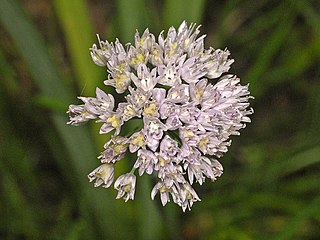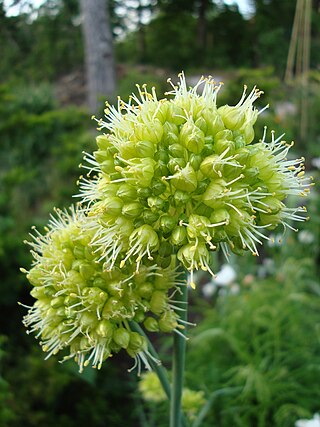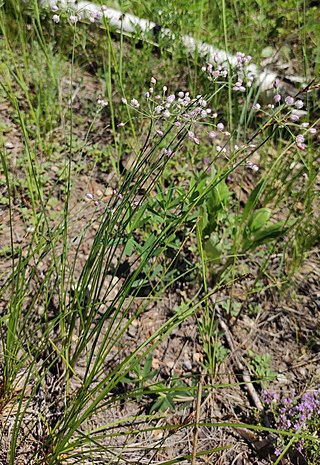
Lilium pumilum is an Asian species of bulbous plants native to Mongolia, Siberia, the Russian Far East, Korea and northern China.
Allium przewalskianum is an Asian species of wild onion in the Amaryllis family.

Allium strictum is a Eurasian species of wild onion. Its native range extends from France to Yakutia.
Allium amphibolum is a species of onion native to Altai, Tuva, Kazakhstan, Mongolia, and the Province of Xinjiang in western China.

Allium atrosanguineum is an Asian species of onion native to China, Siberia, Mongolia, and Central Asia. It grows high in the mountains at elevations of 2400–5400 m.

Allium clathratum is a species of onions native to temperate Asia. It grows on dry slopes and cliff faces at elevations of 400–2000 m.
Allium eduardii is a plant species native to Russia, Mongolia, and northern China.

Allium ledebourianum is an Asian species of wild onion native to central and northeastern Asia: Kazakhstan, Mongolia, Russia, and China. It occurs at elevations up to 1800 m elevation.
Allium leucocephalum is an Asian species native to Buryatiya, Zabaykalsky Krai, Mongolia, Inner Mongolia, Gansu, and Heilongjiang.

Allium lineare is a Eurasian species of wild onions with a wide range extending from France to Mongolia.
Allium longistylum, also called riverside chive, is a species of wild onion native to Korea and northern China. It grows at elevations of 1500–3000 m.

Allium macrostemon, Chinese garlic, Japanese garlic or long-stamen onion, is a species of wild onion widespread across much of East Asia. It is known from many parts of China, as well as Japan, Korea, Mongolia, Tibet and Primorye. It has been collected from elevations ranging from sea level to 3000 m.

Allium maximowiczii, English common name oriental chive, is an Asian plant species native to Siberia, the Russian Far East, Mongolia, Japan, Korea and northeastern China.

Allium obliquum, common name lop-sided onion or twisted-leaf onion, is a Eurasian species of wild onion with a range extending from Romania to Mongolia. It is also widely cultivated elsewhere as an ornamental.
Allium polyrhizum is a species of wild onion widespread across Zabaykalsky Krai, Kazakhstan, Mongolia, and China at elevations 1000–3700 m.

Allium ramosum, called fragrant-flowered garlic or Chinese chives is a northern Asian species of wild onion native to Kazakhstan, Mongolia, Siberia, the Russian Far East, and northern China. The species is also naturalized in a few places in eastern Europe. In its native range, it grows at elevations of 500–2100 m.
Allium subtilissimum is an Asian species of wild onion native to Kazakhstan, Mongolia, Altay Krai, Xinjiang and Inner Mongolia.

Allium tenuissimum is an Asian species of wild onion native to Mongolia, Asiatic Russia, Korea, Kazakhstan and China.

Allium tulipifolium is an Asian species of wild onion native to Xinjiang, Kazakhstan and Altay Krai. It is found at elevations of 600–1000 m.

Gagea hiensis is a species of flowering plant in the lily family. It is native to Korea, Mongolia, China, and Far Eastern Russia.













